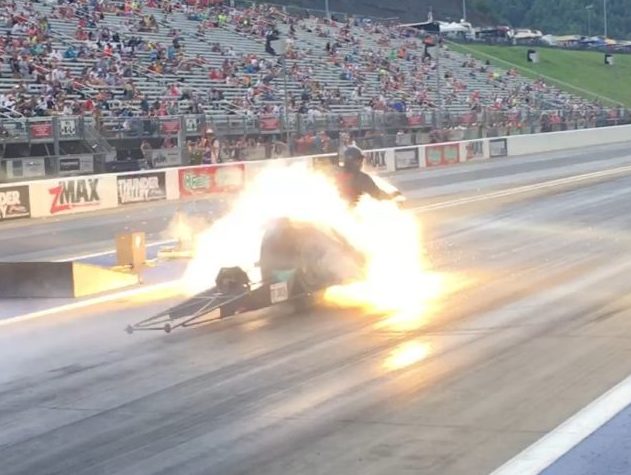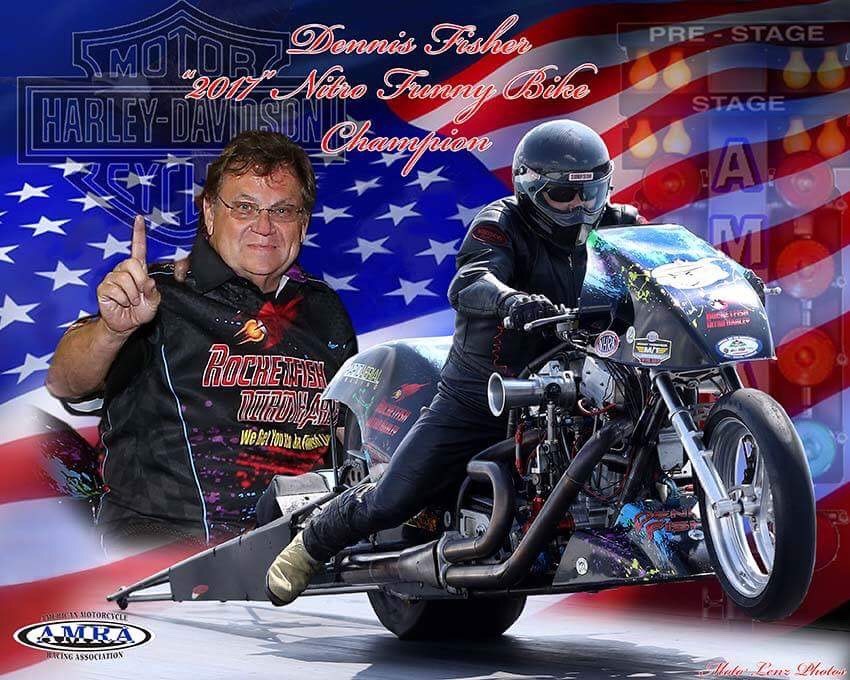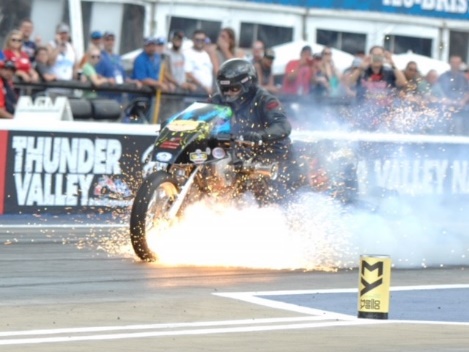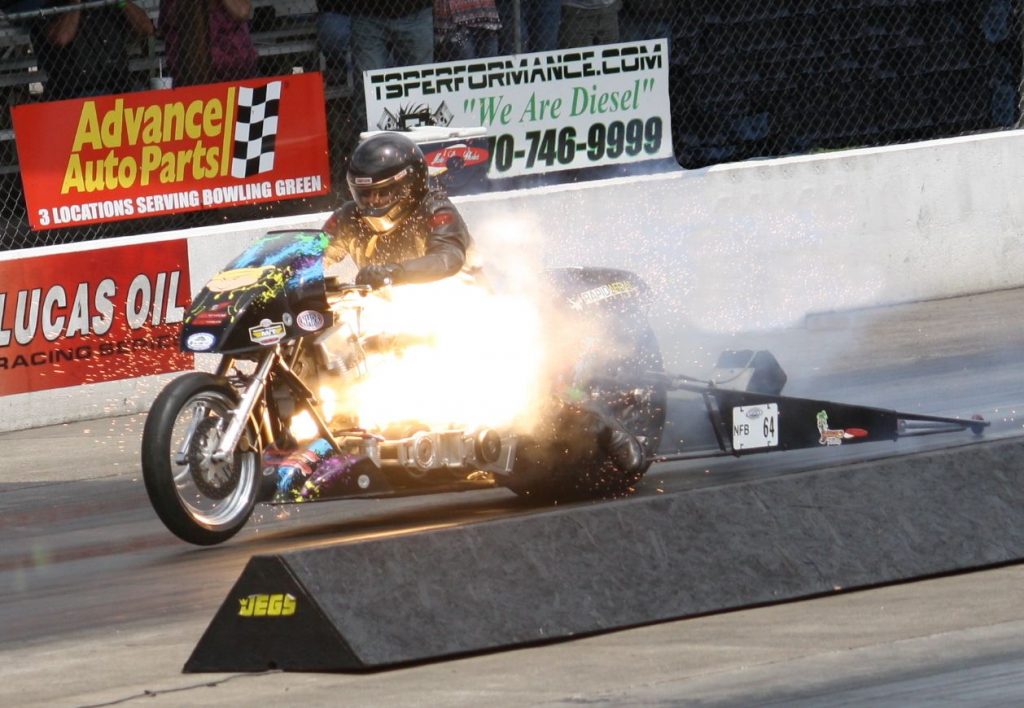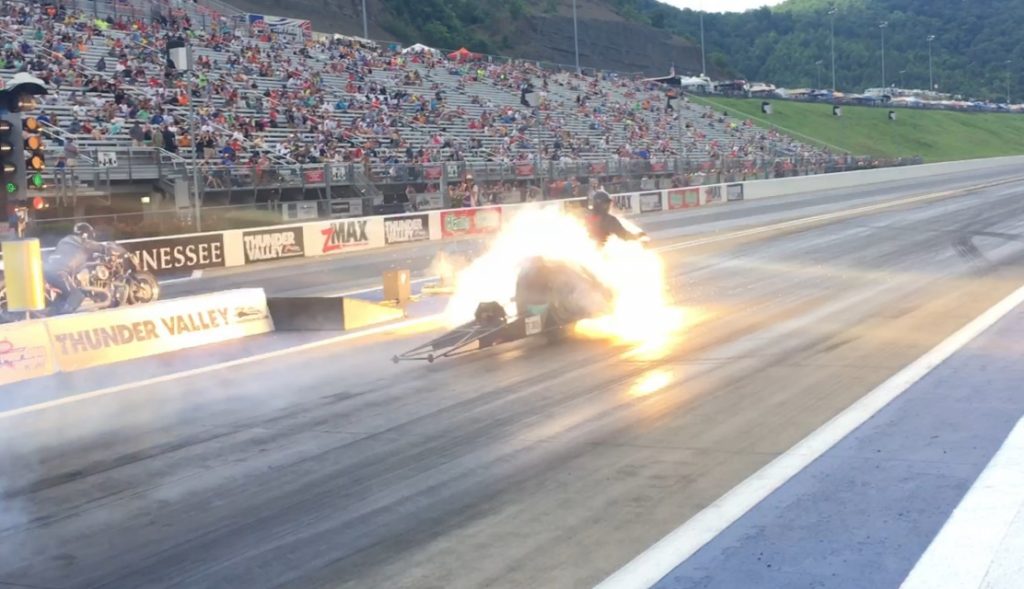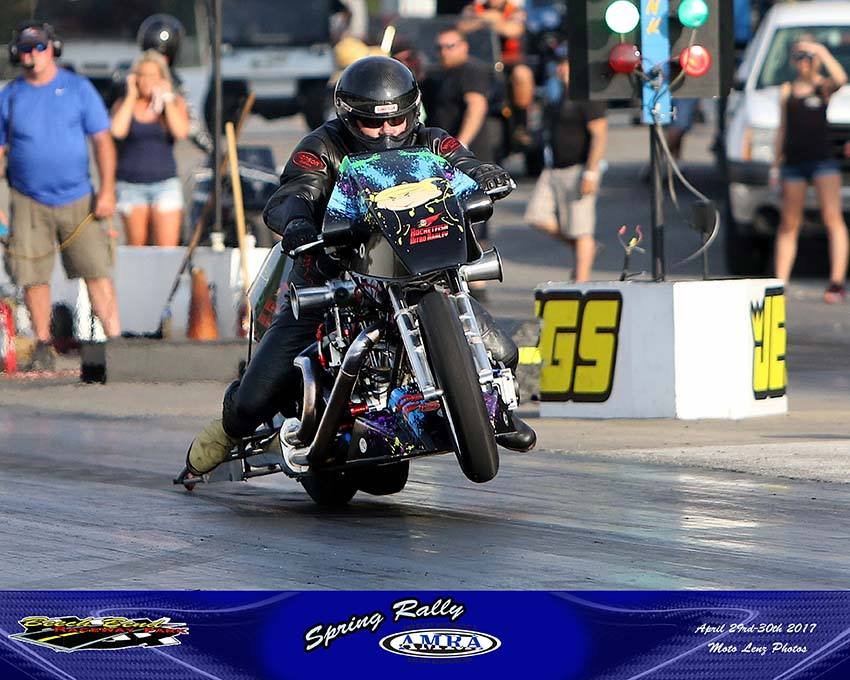So You Want To Ride Top Fuel/Nitro Funny Bike?
Talk about a wild year! A couple of years ago I wrote an article about my experience riding a Pro Fuel Nitro Harley. For those of you that recall that article, there are very few similarities between the Nitro Funny Bike and the Pro Fuel, and the differences are significant.
The NFB is a much heavier bike, maybe 100 lbs or so. The astute observer will note there’s no dump can, and an extra velocity stack – one on each side of the motor. The reason for the extra velocity stack is because this motor is equipped with fuel injection – one throttle body for each cylinder. A few other VISIBLE differences – bigger rear tire, bigger chain, and oh – there’s that square bundle of laundry hanging on the wheelie bar, also known as a parachute. Since these beasts frequently play on the other side of 200 MPH, the rules require a parachute to aid in bringing the rocket to a halt.
What’s unseen is even more mind-boggling. Programmable ignition and timing, timers and valves to control fuel pressure and mapping, clutch engagement, a transponder to trigger ‘chute deployment, and many more data capture sensors.
Stepping up to the NFB from Pro Fuel was an eye-opener in increased complexity. Whereas the Pro Fueler was carbureted and had basic timers for lean-outs and limited ignition timing, the TF/NFB increases its sophistication and complexity by orders of magnitude – we have many more timer channels to be concerned with. Fuel pressure and timing mapping. Clutch management. Rev limiter (if you get there you’ve got other problems). Oh – don’t forget the parachute – and the red button that launches the laundry. I said many times early in the season if I knew ahead of time how much more complex the systems were on this bike, I may not have pulled the trigger. One thing stays the same though – grinding clutches is the same, and it still sucks!
There’s another thing that stays the same – the crucial importance of the crew. Early on in my racing career, my mentor Rickey Gadson (all this racing stuff started after attending Rickey Gadson’s Drag Racing School) hammered home the most important point – to succeed, having a capable and committed crew was an absolute, non-negotiable requirement. And after several iterations, I’ve found it. Steve Vickers of Hawaya Racing (who interestingly enough was involved in building this bike in 2011) is our Championship Crew Chief. Rick “Griz” Smoot of Smoot Construction is our “Chief Wrench” and renowned culinary expert. Rick’s partner, Kristi Bates is our Safety Officer and clutch prep/QC assistant. Kristi keeps us all safe and nourished. Being a long-time healthcare professional, she is invaluable to the team. This crew keeps me safe and is an enormous boost in confidence when throwing a leg over this bike.
The process of starting the bike is similar to Pro Fuel, but there are differences in systems. After a year of observing the process, I’m still not comfortable with trying to fire this bike without one or both of my crew present. One mistake and a bomb with no fuse goes off. The process goes like this –
1) Bike on the starter stand
2) Starter cart shaft in motor
3) Ignition on
4) Engage starter cart
5) Spray gas/alcohol mix from SureShot cans in each throttle body
6) Turn on fuel
7) Disengage starter cart
8) Adjust injector air bleeds to equalize cylinder temps
Once fired and stabilized, we roll to the water box. Griz stops me at the leading edge of the water and wipes the front tire and we light it up, holding revs 4000 or so. Don’t hit the limiter, because if you do, things get real quiet and real embarrassing! Ease out of the water, and head to Chief Vickers whose foot is right where he wants the bike lined up. Griz is behind assisting in getting me lined up straight. Once that’s accomplished, Griz is tasked with the impossible – getting the ‘chute safety pulled from a moving target that is shaking violently while nitro fumes are making it impossible to see or breathe!
One thing I’ve noticed in all the video and photos of us staging and launching – as soon as they’re able, everyone – Griz, Kristi, Steve, others in close proximity – all have fingers in their ears – and for good reason. There is no sound like it, and if you don’t cover your ears, it hurts!
Comparing the ride of a NFB to a Pro Fueler is interesting. The front half is actually similar to the Pro Fuel ride – at least it was this year, but this was a “dial-it-in” year. Our 60’ times were similar to the PF, but we should be closer to 1.10 than 1.20. We’ll get there.
Where things get interesting is at the eighth. The Pro Fueler would lay over about that point – the front wheel would come down quickly and if the wheel wasn’t 100% straight, you get that fleeting wash-out/face plant sensation that comes and goes as long as you stay in the throttle. With the NFB, the eighth is where it comes to life. The pull is stronger, you’re still on the bar, the front wheel is in the air and the ride is getting crazy. Wind, buffeting, vibration fight to drive you off your target. While all this is going on, paying attention to the seat of your pants for tire shake/spin is crucial. These bikes have the ability to blow the tire away anywhere on the track.
On a good pass, the front wheel eases down around 1,000’. Many times you don’t even feel the touchdown. Spectators understand the higher speeds when they see the puff of smoke from the wheel touching down – not unlike an airliner touching down!
With the increased speeds it’s critical to tuck and get as small as possible – and keep a firm grip on the bars. Knowing the track and where the bumps are – and how to avoid them is huge. Once through the traps it’s time to get the rocket hauled down. First order of business is off the throttle, flip the fuel shut-off switch and get on the rear brake to settle the beast. Then punch the ‘chute button on the left bar. By then, you’ve slowed enough to start getting on the front brake, but not too much! Squeezing both brakes gets the bike slowing down enough to plan your exit from the track. Not as important for the Pro Fuelers or gas bikes, but our Top Fuel/NFB’s must make the planned exit for a post-run ritual unique to these bikes.
Every TF/NFB crew positions buckets of water or garden sprayers full of water to cool the clutch basket. These bikes create so much heat in a pass the basket must be cooled as soon as possible, otherwise the clutch can melt the carbon Kevlar belt – and at $500 each, you learn quickly the importance of cooling the clutch as soon as you turn off the track. The challenge is getting the bike off the track, making sure the ‘chute is clear of the track and getting water on the clutch while waiting on your crew to get there to take over the post-pass tasks. Most times you don’t even have time to get your gloves and helmet off until after the crew arrives, then you can start shedding race gear to cool yourself.
Once the bike is secured, you start the tow back to the pits to go to work on turning the bike around for the next pass. The tow back can be physically demanding and is a skill in and of itself. The tow strap wraps around the left grip. When the pit bike takes off it wants to pull the bars full right, so you’re using all the upper body strength you can to keep it straight while shifting your weight to keep the bike behind the pit bike. Once up to speed, you can relax a bit. Negotiating traffic and turns adds to the stress level, but once back at your pit it’s time to get to work.
The first order of business is “blowing out” the motor to make sure there’s no nitro in the cylinders. Then draining oil, changing plugs, reading the data, making any tune-up adjustments, refueling, adding oil and going over the bike front to back. One critical new skill I had to learn – and a major difference between TF/NFB – how to pack and load a parachute! Now that’s fun!
There is one point I have to emphasize – none of this would be possible without this incredible crew. We are thrilled to bring Steve Vickers his first championship as a Crew Chief, and it was overwhelmingly gratifying to win the 2017 NFB Championship with the support of Griz and Kristi in their first year of nitro racing. Another interesting point is both Griz and I started our racing careers on Harley Davidson VROD Destroyers – the purpose-built drag bike Harley made in 2006 to spark grassroots interest in drag racing. Looks to me like it worked!
When nitromethane is good, it’ll give you the ride of your life.
When nitromethane is BAD, it’ll give you a ride you’ll never forget!
2017’s race season took an interesting twist in October of 2016. While the events of a particularly fateful day may be the subject of a future article, that day formed a championship season.
My 2017 plans were to campaign a Top Fuel Harley, and there was an extraordinary one for sale. I flew to Romine Racing in Sturgis, MI to look at Jim Fagan’s TF Harley, and it was everything and more than I expected. I had a check in my pocket to do the deal, but a meeting I had earlier that morning put a wrinkle in my plans.
Fate intervened and delayed the purchase a few weeks. During that time, Billy Jackson approached Jim about the bike, and being the gentleman he is, Jim contacted me first to see where I was with the transaction. Still unable to pull the trigger, I told Jim he had to do what was best for him, and I appreciated the opportunity but I would have to pass.
Billy and I are racing pals and he immediately called to see if I was pissed at him for buying the bike out from under me. I assured him I wasn’t, there were issues I needed to resolve before making that commitment. Billy, being the gentleman he is, extended an extraordinary offer to sell me his Funny Bike program once I got my issues sorted out.
And that’s how I ended up on a Nitro Funny Bike!
We tested in March and overcame lots of annoying glitches. Some bike, some support equipment, but when we finally got rolling, my third pass was the first full pull and we clocked a 7.03 at 193 MPH. It’s been a steady progression since then.
Keep in mind this is a new bike, new support equipment, new systems, new computers and most of all a NEW TEAM. We were all trying to figure who and what fit where.
Before the season even started we had our haters. I was scolded on social media for pulling the plug on my Pro Fuel program when the championship was there for the taking. No, it wasn’t. The standings were about to flip because the team didn’t understand the NHRA point system (best 7 of 10 events). Even more critical was why the bike was two-tenths slower than the eventual champ. A post-mortem on the bike revealed a broken coil wire that ran half of the ignition. Regardless of what we did, runner-up was the best (and worst) we were going to be. The same social media rant said I wasn’t worthy of riding Harleys, that I was going to get hurt, that I should go ride metrics, blah, blah, blah…
If I listened to doubters and haters in my life I would have never achieved any goal I’ve set. And I’ve set plenty! Like my good friend Billy Jackson says, “Don’t let fear and common sense hold you back”!
The first few races of the season saw us winning rounds, but having an unusual failure, usually in the finals. We were spitting out pushrods because we were melting the end of the pushrod at the rocker arm. Once we realized we had a lubrication issue, we were able to correct that. No further issues the rest of the year.
Another issue we had was premature ejection of the parachute (double entendre intended;-)). While a seemingly simple problem to fix, it took us a while to get it right.
Throughout the year, and until the last race where we won the championship, we struggled with clutch management. To quote our Crew Chief, Mr. Fabulous, Steve Vickers – “we didn’t have a fully functioning bike until the last race”.
We took a misguided detour in June to participate in the Thunder Valley Nationals. We reconfigured the bike for Top Fuel, but clutch problems continued to plague us and we ended up with a rather spectacular blowup at the hit that Fox Sports highlighted on national television. After replaying my fireworks display, Fox announcer Dave Rieff asked Tony Pedregon if he still wanted to get on a Top Fuel Harley – to which Tony replied, “not even with my 7-layer fire suit”! Dave also asked me what I was looking down at after the explosion – to which I replied, “what do you think I was looking at”? Thankfully, all was intact!
We put the bike back together for the June AMRA event at Bowling Green and hit a low point in the season – another blow up at the hit. When a photographer came by and said he had a really cool shot of me on fire, I snapped and said “I’m really tired of these cool photos”! At that point I seriously thought about pulling the plug on the season. The prior 2 events were big hits to the wallet.
After emotions calmed down, we evaluated where we were and what our chances were for the championship. Though we had given up precious points, we still had a shot. The team was encouraging me to hang in there. Salt was not done with being poured in the wound though. I learned after the Bowling Green debacle we had the parts in the trailer to fix the bike – and probably go rounds. I was pissed at myself for not having a better grasp of our spares inventory. Suck it up buttercup and move on. Lesson learned, that problem will never resurface.
The next few events saw us significantly close the gap to the points leader, and back at Bowling Green in September – where we achieved a milestone that made our season. During qualifying, we set a new 1/8 mile MPH record – shattering the prior record of 186 MPH – resetting it to 192.62 MPH. The resulting bonus points for the record closed the gap to the points leader to 15!
The Championship was going to be decided during the Jim McClure Nitro Harley Nationals at “The Rock”.
This was a tense weekend with no shortage of drama. I knew all weekend we just had to go one more round than the points leader. I could not have imagined it would unfold the way it did.
There were several entrants we hadn’t seen previously, and that sure could mix things up a bit. While we qualified better than the points leader, there was a bike or two quicker than us. Adding to the uncertainty, Kirby Apathy ran some good numbers on his new FB and he’s always a threat.
In round one we had one of the gas bikes entered (former pro stock) and though he did exactly what Johnny Vickers told me he would – get out in front of us early – we drove by him at 660’ and took the round. The points leader handled his opponent (Rocky Jackson) in round 1 which set him up for round 2 against the Browne Racing turbo Harley. I was beginning to get a picture of how this day would go.
Just before the second round I learned the Browne entry couldn’t make the call due to tranny issues. My 2nd round opponent would be Kirby on his new FB. At this point I’m asking myself what it takes for us to get a break! I knew Kirby could be a challenge, even though we out-qualified him. Working off some nervous energy I was heading to the lanes and making my way around Kirby’s pit when they were getting ready to heat-cycle the bike. Something went wrong and the bike blew – scaring the crap out of me, not to mention Kirby and his crew. It lifted the heads and the crews’ ears were ringing for a while. Fortunately and thankfully, no serious injuries other than motor parts.
It was now clear what was going to take place. Me vs. the points leader in the final round. No stress there.
I offered to make the semifinal round the final as each of us would have a bye. Our opponent declined, insisting he needed the data for a final round tune-up. Understandable. Our decision was do we break the beams and save the equipment, or make a pass looking for lane choice. Mr. Fabulous (Crew Chief, Steve Vickers) made it clear he wanted lane choice, so the decision was made.
The points leader went first, laid down a 6.82 if my memory is correct. Then we threw down the gauntlet with a 6.75. I was feeling pretty good about where we stood, but I also knew our opponent would be making some adjustments to his tune-up.
Round 3 comes, the sun is setting and is no longer a factor in lane choice. We take the right lane. Our opponent is trying to hurry us, but I’m not getting out of our well-practiced routine. He pre-stages first, I pre-stage. Not wasting any time, our opponent rolls into the beams and stages. I follow. Adrenaline, heart and respiration rates are on the rev limiter!
We cut the best tree of the year at 0.040, our opponent had 0.089. With these bikes, anything with a “0” is considered a good light. I knew we got out in front at the hit, and it stayed that way throughout the pass. We were on a decent pass, straight as a string. The wheel touched down around 1,000’ and we went through the traps at 6.77 and 202 MPH. Our opponent – and now runner-up to the new champion – ran a 6.78 at 202. This was one heck of a drag race.
Back at the line my crew was going crazy – and the former champ’s crew was most gracious in their congratulations to us. It was an unbelievable end to an improbable season. Rookie to champ in less than a year!
I owe this championship to this incredible crew – guys who stuck with me and took a chance on someone who had never been on a Funny Bike. It is an enormous boost to your confidence when the crew says you can ride on your first outing – all I can say is thanks, and I can’t thank them enough.
I also want to thank Johnny Vickers and Hawaya Racing. They built this bike originally, and though it’s been through a couple of different owners before me, they knew it well and knew what it needed to perform.
We’re already looking forward to 2018 and excited about our prospects – we’re going to pick up right where we left off – and then some! We know our competition will be stepping it up, so we cannot stand still. Ryan Peery, Kirby Apathy, Randall Andras, Chris Smith, Rocky Jackson and Rich Vreeland are all formidable competitors. And we hear there’s a new Funny Bike being built. 2018 looks to be an exciting year for Nitro Funny Bike in the AMRA. And we may consider revisiting the Top Fuel configuration at a few events too. Keep an eye out for the RocketFish Nitro Harley race team coming to a track near you!


